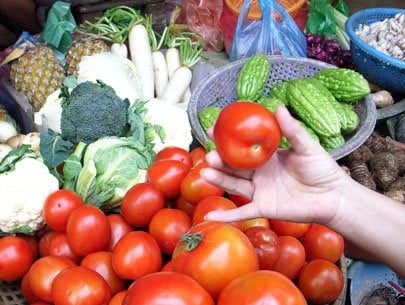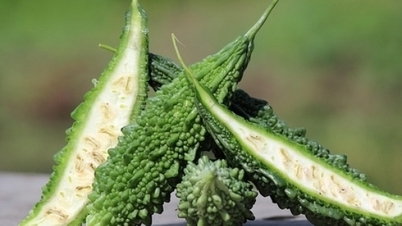Meals with a variety of fruits and vegetables provide vibrant colors, stimulate the senses, help increase appetite, and provide many biological active ingredients that are beneficial to health.

Colorful fruits and vegetables are good for health - Photo: TTO
Precious nutrients from vegetables and fruits
According to Dr. Huynh Nam Phuong, National Institute of Nutrition, basically all foods have all the nutrients, but some foods have more of this substance, others have more of that substance. All foods can be made into different nutritional diets.
From a nutritional perspective, there is no single food that can be considered a “good food” or a “bad food” in and of itself. What matters is the combination and complementarity of foods to meet an individual’s energy and nutrient needs.
Therefore, it is necessary to eat a variety of foods and divide them evenly into meals during the day. A varied diet means eating foods from all food groups in a balanced proportion every day, and choosing a variety of foods within a group.
Vegetables and fruits are a source of vitamins and minerals necessary for the life and development of the body, helping to protect the body and strengthen health against disease.
Vegetables are generally low in fat, cholesterol, and salt, but provide complex carbohydrates, fiber, and other nutrients.
Fruits and vegetables are mostly low in energy, contain natural sugars instead of refined sugars (like those found in industrially processed sweets) so they do not cause a sudden increase in blood sugar after eating. This is especially good for people with or at risk of metabolic diseases.
Vegetables also provide fiber which is beneficial for the digestive system, stabilizes intestinal bacteria, prevents constipation, helps stabilize blood sugar, and reduces blood cholesterol.
A diet rich in fruits and vegetables can help reduce the risk of heart disease, stroke, obesity, kidney stones, some cancers, type 2 diabetes, and bone disorders.
Some valuable nutrients from vegetables and fruits such as fiber; folate; potassium; vitamins A, C; iron.

A Tet meal with lots of vegetables will help lighten the stomach and prevent boredom.
Benefits of 'rainbow' fruits and vegetables
Fruits and vegetables can be divided into five groups according to their color: red, purple/blue, orange, green and white/brown. Each color contains a group of bioactive compounds that have a specific effect in preventing a certain type of disease.
It is these bioactives that give fruits and vegetables their vibrant colors and their health benefits.
Red: Red fruits and vegetables are colored by a natural plant compound called lycopene. Lycopene is a powerful antioxidant that has been linked to reduced cancer risk and heart health.
Red fruits and vegetables are also rich in important vitamins and minerals such as potassium, vitamin A, vitamin C and folate. This group of fruits and vegetables therefore helps vision and the immune system and reduces the risk of urinary tract infections.
Purple/blue: Plant compounds called anthocyanins give fruits and vegetables their blue color. They also have antioxidant properties that help protect against cell damage and reduce the risk of cancer, stroke, and heart disease.
Orange/yellow: is due to carotenoids. A common carotenoid is betacarotene, which is found in sweet potatoes, pumpkins, and carrots.
This substance is converted into vitamin A in the body, which helps protect mucous membranes (digestive and respiratory tracts) and eye health. Yellow and red fruits and vegetables also contain a lot of vitamin C, which helps boost immunity and metabolism.
Green: Green vegetables contain bioactive compounds including carotenoids, chlorophyll, indoles and saponins, which have anti-cancer properties. Green leafy vegetables such as spinach and broccoli also contain folate (Vitamin B9), vitamins A, C, K, etc.
Brown/white: fruits and vegetables of this color contain many biological active substances such as allicin (in garlic) which has anti-viral and anti-bacterial properties, reducing the risk of high blood pressure, lowering blood cholesterol, cancer and cardiovascular disease.
Garlic and onions contain antioxidants called polyphenols, which play an important role in fighting chronic inflammation. Some of these vegetables, such as bananas and potatoes, are also good sources of potassium. The glucosinolates in cauliflower have been shown to protect against cancer.
How many fruits and vegetables should you eat every day to get the most benefits?
According to the recommended nutrition pyramid for Vietnamese people built by the Institute of Nutrition, vegetables and fruits are the 6th food layer (out of 7 layers) with the recommended daily intake being second only to cereals.
The number of units consumed is 3-4 units of vegetables and 3 units of ripe fruit (each unit is equivalent to 80g of vegetables/fruit, about 1 bowl of vegetables, 1 medium banana, 1 orange, or 1 piece of mango).
The US Department of Agriculture also recommends that people eat at least 5 to 9 servings of fruits and vegetables every day. However, the quantity of fruits and vegetables is not the only thing to consider, we need to eat a variety of fruits and vegetables with different colors.
Eating a rainbow of fruits and vegetables helps us get a variety of nutrients essential for good health.
Different colors of fruits and vegetables represent different nutrients they contain, so eating a little of each color every day will maximize the nutritional benefits.
Source: https://tuoitre.vn/bua-an-ngay-tet-rau-qua-nhieu-mau-nhu-cau-vong-co-loi-cho-suc-khoe-20250125182044832.htm


![[Photo] Prime Minister Pham Minh Chinh chaired a meeting to evaluate the operation of the two-level local government model.](https://vphoto.vietnam.vn/thumb/1200x675/vietnam/resource/IMAGE/2025/10/29/1761751710674_dsc-7999-jpg.webp)
![[Photo] New-era Party members in the "Green Industrial Park"](https://vphoto.vietnam.vn/thumb/1200x675/vietnam/resource/IMAGE/2025/10/30/1761789456888_1-dsc-5556-jpg.webp)

![[Photo] Fall Fair 2025 - An attractive experience](https://vphoto.vietnam.vn/thumb/1200x675/vietnam/resource/IMAGE/2025/10/30/1761791564603_1761738410688-jpg.webp)






































































































Comment (0)